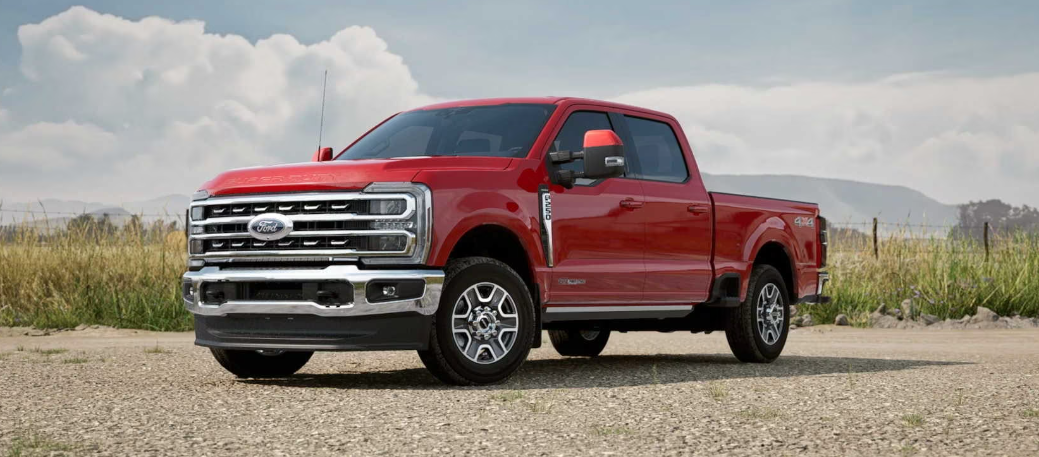2023 FORD F-250 Sensors Guide
Introduction
A masterpiece of innovation and efficiency, the 2023 Ford F-250 is now available. With the 2023 Ford F-250, an engineering marvel that flawlessly combines power, performance, and cutting-edge technology, you may step into the future of automotive perfection. A network of cutting-edge sensors is at the core of this powerful truck, ushering in a new era of safety, convenience, and unmatched driving experience.
The 2023 Ford F-250 redefines what it means to drive confidently thanks to its array of cutting-edge sensors. Advanced functions like adaptive cruise control, blind-spot monitoring, and automatic emergency braking are made possible thanks to the harmonic cooperation of radar and ultrasonic sensors. These sensors serve as watchful defenders, making sure you and those around you are safe.
Sensors
LOCATING THE BLIND SPOT INFORMATION SYSTEM SENSORS

The sensors are inside the brake lamp on both sides of your vehicle.
Note: Keep the sensors free from snow, ice and large accumulations of dirt.
Note: Do not cover the sensors with bumper stickers, repair compound or other objects.
Note: Bike and cargo racks could cause false alerts due to obstruction of the sensor.
We recommend switching the feature off when using a bike or cargo rack.
Note: Blocked sensors may affect system accuracy.
If the sensors become blocked, a message appears in the instrument cluster display.
The alert indicators illuminate but the system does not alert you
BLIND SPOT INFORMATION SYSTEM WITH TRAILER COVERAGE
WHAT IS BLIND SPOT INFORMATION SYSTEM WITH TRAILER COVERAGE

Blind spot information system detects vehicles that may have entered the blind spot zone. The detection area is on both sides your vehicle and trailer, extending rearward from the exterior mirrors to the end of your trailer.
BLIND SPOT INFORMATION SYSTEM WITH TRAILER COVERAGE LIMITATIONS
Trailer coverage supports conventional trailers automatically. To function with unconventional trailers such as fifth wheel and gooseneck variants, the vehicle needs to have trailer accessory sensors
connected. Make sure the trailer width is less than or equal to 8.5 ft (2.6 m) and the length is less than 33 ft (10.1 m) for conventional trailers and less than 50 ft (15.2 m) for unconventional trailers. If you input values higher, the system turns off.
Some trailers could cause a slight change in system performance:
- Large box trailers could cause false alerts to occur when driving next to infrastructures or near parked cars. A false alert could also occur while making a 90-degree turn.
- Trailers that have a width greater than 8.5 ft (2.6 m) at the front and have a total length greater than 20 ft (6 m) could cause delayed alerts when a vehicle is passing at high speeds.
- Box trailers that have a width greater than 8.5 ft (2.6 m) at the front could cause early alerts when you pass a vehicle.
- Clam shell or v-nose box trailers with a width greater than 8.5 ft (2.6 m) at the front could cause delayed alerts when a vehicle traveling the same speed as your vehicle merges lanes.
Please contact your dealership for more information about trailer blind spot accessory sensors.
BLIND SPOT INFORMATION SYSTEM WITH TRAILER COVERAGE LIMITATIONS
- Trailer coverage only supports conventional trailers. The system turns off if you select a fifth wheel trailer type.
- Make sure the trailer width is less than or equal to 8.5 ft (2.6 m) and the length is less than 33 ft (10.1 m). If you input values higher, the system turns off.
Some trailers could cause a slight change in system performance
- Large box trailers could cause false alerts to occur when driving next to infrastructures or near parked cars. A false alert could also occur while making a 90-degree turn.
- Trailers that have a width greater than 8.5 ft (2.6 m) at the front and have a total length greater than 20 ft (6 m) could cause delayed alerts when a vehicle is passing at high speeds.
- Box trailers that have a width greater than 8.5 ft (2.6 m) at the front could cause early alerts when you pass a vehicle.
- Clamshell or v-nose box trailers with a width greater than 8.5 ft (2.6 m) at the front could cause delayed alerts when a vehicle traveling the same speed as your vehicle merges lanes.
LOCATING THE EXIT WARNING SENSORS
 The sensors for exit warning are mounted behind the rear bumper on both sides of your vehicle.
The sensors for exit warning are mounted behind the rear bumper on both sides of your vehicle.
Note: Keep the sensors free from snow, ice and large accumulations of dirt.
Note: Do not cover the sensors with bumper stickers, repair compound or other objects.
Note: Blocked sensors may affect system accuracy.
Note: The system may not correctly operate when towing a trailer or bike rack.
Note: Holding the pressure washer nozzle at an angle to the vehicle’s surface may damage graphics and cause the edges to peel away from the vehicle’s surface.
CLEANING CAMERA LENSES AND SENSORS
We recommend that you only use lukewarm or cold water and a soft cloth to clean the camera lens and sensors.
Note
Do not pressure wash camera lens and sensors.
CLEANING THE UNDERBODY
Flush the complete underside of your vehicle frequently. Keep body and door drain holes free from packed dirt.
FAQs
A multitude of sensors are included in the 2023 Ford F-250 to improve safety, functionality, and convenience. These include sensors for lane departure warning, parking assistance, blind-spot monitoring, airbags, tire pressure monitoring, and more.
The 2023 F-250’s Anti-lock Braking System (ABS) sensor keeps track of each wheel’s speed. In order to avoid skidding and retain steering control, it changes the brake pressure if it notices a wheel locking up when braking.
The airbag sensor tracks different driving characteristics and acceleration to look for crashes. It causes the airbags to deploy in the case of a collision, giving occupants additional safety.
Tire pressure is continuously monitored by the TPMS sensor. It warns the driver via a warning light if it notices low tire pressure, helping to avoid risky driving situations and tire damage.
The sensors for parking assistance use ultrasonic or radar technology to find things in the area around the car as it is being parked. To help the driver avoid collisions with impediments, they deliver audio or visual alerts.
Radar is used by the blind-spot monitoring sensor to keep an eye on the car’s blind spots. It warns the driver if there is a car in the lane next to them, reducing the chance of accidents when changing lanes.
The vehicle’s position within the lane is tracked by the lane departure warning sensor, which also recognizes lane markers. The device warns the driver if the car starts to veer off course without using its turn signal.
Yes, the 2023 F-250 often has adaptive cruise control, which keeps a certain distance from the car in front using radar sensors. It automatically modifies the speed of the car to account for traffic circumstances.
The windshield’s moisture is discovered by the rain-sensing wiper sensor. When rain is detected, it automatically turns on the wipers and modifies their speed according to the amount of rain falling.
The ambient temperature sensor determines how hot or cold it is outside. The temperature system of the car is managed using this information to maintain the best possible cabin comfort.
The automated headlights of the 2023 F-250 are frequently managed by a sensor that gauges the amount of ambient light. The sensor turns on the headlights when it gets dark outside.
A precise reading of the fuel level is provided to the driver by the fuel level sensor, which detects the amount of fuel in the tank and transmits this information to the vehicle’s fuel gauge.
The tire temperature sensor keeps track of the tires’ temperature. Tire blowouts can be avoided by using elevated tire temperatures to identify problems like overinflation or excessive friction.
Yes, a trailer sway control feature that uses sensors to detect trailer sway is available on many 2023 F-250 vehicles. For the purpose of stabilizing the vehicle and trailer, it applies individual wheel braking and modifies engine torque.
Depending on the type of sensor and the systems of the vehicle, different calibration and reset methods may be required. For precise directions on calibrating or resetting sensors in the 2023 F-250, consult the owner’s manual. If doubtful, it is recommended to speak with a skilled technician or a dealership.
Useful Links
View Full Manual: 2023 FORD F-250 Owner’s Manual | Auto User Guide
Download Manual: Ford Vehicle Owner Manuals | Ford


